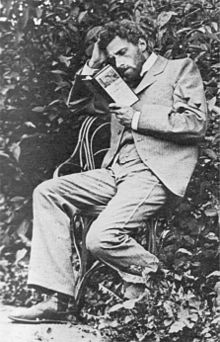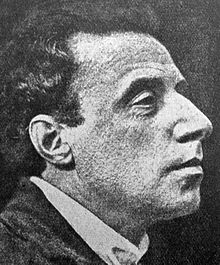Vsevolod Emiljewitsch Meyerhold

Vsevolod Meyerhold ( Russian Всеволод Эмильевич Мейерхольд , scientific. Transliteration Vsevolod Ėmil'evič Mejerchol'd , originally Karl Kasimir Theodor Meier Hold * January 28 . Jul / 9. February 1874 greg. In Penza , Russian Empire ; † 2. February 1940 in Moscow , USSR ) was a Russian director and actor . He was the developer of a radical anti-realist stage art and is considered one of the most important theater directors of the 20th century . He fell victim to the Stalin purges .
Life
Wsewolod Meyerhold came from an Evangelical Lutheran family and was the son of Emil Meyerhold , a wine merchant of Jewish descent who had immigrated from Prussia , and his wife, the German-Baltic woman Alwina Van der Neese. After Vsevolod Meyerhold finished school in 1895, he began studying law at Moscow University , which he broke off. On his 21st birthday he converted to Russian Orthodox Christianity and took the name "Vsevolod Emiljewitsch". During this time he also married his first wife, Olga Munt, with whom he had three daughters, including Irina Meyerhold .
His acting career began when he began studying at the State Institute for Theater Arts . Among other things, he learned from Vladimir Nemirowitsch-Danchenko . From 1898 Meyerhold was a member of the ensemble at the Moscow Art Theater , where he was strongly influenced by Konstantin Sergejewitsch Stanislavski and participated in many productions there.
His career as a director began in 1902. In the first few years he was strongly oriented towards realism , but from 1905 he turned away from it entirely. He developed an innovative symbolist style.
During his time at the Sankt Petersburg Wera Komisarschewskaja Theater (1906–1907) his artistic skills matured. He recorded this period of his work in his first book Theater: History and Techniques (1907). Soon Meyerhold also staged performances at the state theaters of Saint Petersburg. He performed classical plays in an innovative way , focusing on controversial contemporary authors such as Fyodor Sologub , Sinaida Gippius and Alexander Blok . His performances were often shaped by many different influences and style elements. In 1913 he wrote his second book About the Theater .
The world outside Russia soon became aware of this interesting man, and he staged productions in various major European cities, including Paris . Although the avant-garde of Russian artists and intellectuals enthusiastically supported Meyerhold, he also had opponents. Above all, the state institutions of the tsarist empire demanded a conventional, realistic type of theater. After the October Revolution of 1917 Meyerhold became more and more committed to the Communist Party ; he was a supporter of the idea of the Soviet theater. In the same year he opened his own theater, which still bears his name today. In the late 1910s he also experimented with the medium of film . Among other things, he directed a film adaptation of Oscar Wilde's The Portrait of Dorian Gray .
After Meyerhold was imprisoned by the anti-Soviet White Army in 1919 , he fell ill with tuberculosis . After his liberation by the Red Army , he returned to Moscow. There he became head of the new state administrative department for theater and drama. He worked out a program of the new Russian theater that was similar to the aestheticism of the Renaissance . The communist leaders, especially Lenin's wife Nadezhda Krupskaya , did not like his performances, and he lost his position. From 1922 to 1924 he was head of the Moscow Theater of the Revolution , and in 1923 he founded an experimental theater company, the Vsevolod Meyerhold Theater . The actors were trained by Meyerhold himself or by his closest collaborators.
He applied an education he called biomechanics . He combined psychological with physiological processes; his actors used special movements and gestures to express their emotions. Meyerhold said that emotions follow physical processes. So when the body assumes certain poses, the feelings follow naturally. He worked with this group for the next 16 years. He continued to try to create an independent, abstract, intensely dynamic reality on stage. The official criticism honored this and put Meyerhold on a level with artists such as Pablo Picasso , Salvador Dalí , Franz Kafka , Dmitri Shostakovich and Benjamin Britten .
Since 1922 he was married to the actress Sinaida Reich .
In April 1930 Meyerhold made guest appearances with a selection of productions from the past six years at the Theater in Stresemannstrasse and at the Piscator stage in the Wallner Theater in Berlin; in June 1930 a guest performance in Paris followed. At home he was repeatedly accused of anti-Soviet propaganda by the state in the 1930s . He was accused of being politically and ideologically unsuitable for the Soviet population. Most of his productions were not allowed due to strict censorship . He withdrew and devoted himself to a new building project for his theater group. But the project could never be completed.
The Vsewolod-Meyerhold-Theater was forcibly closed in 1938, a year later he was arrested and his wife murdered. He was charged with being a French spy. During interrogations by officers of the Soviet secret police NKVD , he was subjected to severe torture. In the KGB archives there was Meyerhold's pardon to the head of government Vyacheslav Molotov , in which he described the torture in detail: beatings with rubber truncheons, pouring hot water over the bruises. An acknowledgment of receipt by the Molotov secretariat or a response to the letter has not been received.
In a secret trial Meyerhold was sentenced to death by shooting . On February 2, 1940, he was executed in Moscow . The execution with a shot in the neck was carried out by the NKVD executioner Vasily Blochin . Meyerhold's body was cremated and buried in a mass grave in Moscow's Donskoy cemetery .
Meyerhold was rehabilitated in 1955.
Works
- Fonts. Essays - letters - speeches - conversations . 2 volumes. Henschel, Berlin 1979
- Theater. History and techniques , 1907 (new edition: Theater , Methuen, London 1998, ISBN 0-413-38790-9 )
literature
- Ursula Birri: Total theater with Meyerhold and Piscator , Zurich 1982
- Edward Braun: Meyerhold. A revolution in theater , Methuen, London 1995, ISBN 0-413-68770-8
- Ilja Ehrenburg : People - Years - Lives (Memoirs), Munich 1962, special edition Munich 1965, Volume I 1991–1922, pages 474–488, ISBN 3-463-00511-5
- Vsevolod Meyerhold. Theater work 1917–1930 . Edited by Rosemarie Tietze. Carl Hanser, Munich 1984
Individual evidence
- ^ Edward Braun: Meyerhold: A Revolution in Theater . A&C Black, 1998, ISBN 978-1-4081-4880-8 ( google.de [accessed December 3, 2018]).
- ↑ Вадим Гаевский: Потусторонние встречи . Новое Литературное Обозрение, 2018, ISBN 978-5-4448-1046-0 ( google.de [accessed December 3, 2018]).
- ↑ Мейерхольд и его роковая любовь . In: АЛЕФ . ( alefmagazine.com [accessed December 3, 2018]).
- ↑ Родословная В.Э.Мейерхольда. (Выжимка автора из книги). Retrieved December 3, 2018 (Russian).
- ^ Venedikt Sarnov: Imperija zla. Sud'by pisatelej. Moscow 2011, p. 34.
- ↑ Vitaly Sentalinsky: Raby swobody v literaturnych archivach KGB. Moscow 1995, pp. 30-31.
- ↑ Katyn '1940-2000. Documenty. So. NI Lebedeva. Moscow 2001, pp. 35-36.
Web links
- Literature by and about Wsewolod Emiljewitsch Meyerhold in the catalog of the German National Library
- Karla Hielscher: Wsewolod Meyerhold: An avant-garde through and through. In: Deutschlandfunk Kultur. February 2, 2015 .
- Béatrice Picon-Vallin: Vsevolod Meyerhold and his poet actor (PDF file; 1.08 MB)
| personal data | |
|---|---|
| SURNAME | Meyerhold, Vsevolod Emiljewitsch |
| ALTERNATIVE NAMES | Мейерхольд, Всеволод Эмильевич (Russian) |
| BRIEF DESCRIPTION | Russian director and actor |
| DATE OF BIRTH | February 9, 1874 |
| PLACE OF BIRTH | Penza |
| DATE OF DEATH | February 2, 1940 |
| Place of death | Moscow |


